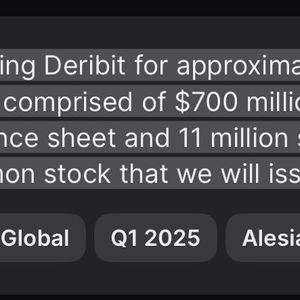Summary Bitcoin's historical cycle top indicators like Pi Cycle and MVRV show plenty of room to run higher for BTC returns. The broader ETF market now holds over 6% of total supply, yet BRRR has not benefited from that inflow. I continue to see BTC as a 'buy' following a technical breakout and a return of investor demand. BRRR will work fine as a long Bitcoin product, though I still prefer FBTC personally. Back in early December, I wrote about the declining dominance of Bitcoin ( BTC-USD ) within the digital asset market. My thinking then was that we could be at the beginning of an 'alt season' in crypto. That turned out to be a poor assessment, as Bitcoin Dominance has continued higher through the five months since that piece was published. The metric has moved from 55% up to 62%: Bitcoin Dominance 5/9/25 (CoinMarketCap) The performance of alts against Bitcoin was so bad that at one point in April, CryptoMarketCap's 'Altcoin Season Index' fell all the way to 12. That number has since reversed higher up to 33 and is now at its highest level in nearly 3 months. In the past, we've seen altcoin out-performance be an indicator of bull market exhaustion. Given that, let's explore some historical cycle top indicators for Bitcoin to see if we should be concerned about a deeper market pullback. Or, is the BTC price now more a product of traditional market capital flows through ETFs like the CoinShares Bitcoin ETF (NASDAQ: BRRR ). Historical Indicators & Performance There are several ratios and models that can be used to assess when Bitcoin's price is at or approaching profit-taking levels. Personally, I don't think it's prudent to use these indicators as forecasts or price targets. Rather, they can help investors/traders assess when price is perhaps getting out of hand relative to its past performance. One such metric that I find useful is the Pi Cycle Top Indicator. This utilizes price with the 111 DMA as well as a 2x multiple on the 350 DMA: Bitcoin Magazine PRO When price gets close to or even well above the 350 DMA multiple, it has historically been an indication that the cycle top has been achieved, and the rally is extended. As of May 9th, the green band on the indicator - which is the 2x 350 DMA - is at $157k per coin. This would imply BTC could rally another 50% from current levels before a sell signal would be triggered. Another metric to consider is the MVRV, or market value to realized value ratio: MVRV Ratio (IntoTheBlock) This is another way of showing when BTC is 'overvalued' based on the premium the market is willing to pay for BTC over the average price paid for each address. Bitcoin is historically 'cheap' when the MVRV is less than 100%. It is currently at 212%. Which I wouldn't say is 'cheap' by any means, but also far from the 435% MVRV Ratio in 2017 and the 373% MVRV Ratio in 2021. More recently, the ratio has eclipsed 260% on two separate occasions going back to March 2024. The question is whether or not Bitcoin holders should expect lower highs in these types of ratios as halving cycles progress. We do know the price performance gains have generally exhibited lower returns each halving epoch: BTC Price Gain By Halving Epoch (IntoTheBlock) The first halving epoch generated a return that eclipsed over 7,000%. The second was about 3,000%. The third was roughly 1000%. Clearly, there should be an expectation of diminishing returns in the price performance if history is a guide. Again, the question is what is a reasonably expected price performance high level for this current halving cycle. I think it would be wise to expect well below half the prior cycle. Frankly, I think even a 200% gain this time around would be ambitious, as that would put the price of BTC close to $190k per coin. But even if we split that and call it 100%, that would put BTC in the $130k per coin range and somewhat close to the Pi Cycle Top Indicator. I think this is a far more reasonable expectation. ETFs & a Capital-Driven Market Ultimately, price comes down to capital flows and demand from products like ETFs as well as companies like Strategy ( MSTR ). There, we're seeing a strong surge in demand, with $5.5 billion in digital asset inflows in the last three weeks: Capital Flows By Asset (CoinShares) Compared with the broader digital asset investment market, Bitcoin is clearly the favorite here, nearly 99% of the total year to date flows coming from Bitcoin alone. If 'altcoin season' is ever going to happen, it certainly doesn't look like it's anywhere close. It's difficult for me to see how the lack of a fresh 'altseason' wouldn't ultimately benefit Bitcoin. Especially since we're still only looking at two assets available through the spot ETF wrapper in the United States - though that could certainly change this year. Regardless, the trend in aggregate BTC held through US-based ETFs is positive: BTC Held Through ETFs/Funds ( Bitcoin Treasuries ) At just shy of 1.4 million BTC, the ETF/CEF funds have grown substantially through the years and now hold over 6% of total supply. Interestingly, BRRR is not a fund that is benefiting from this, as the fund's BTC is lower than where it was a year ago. Admittedly, there are some conflicting third-party numbers pertaining to what BRRR actually holds. The Block has BRRR Bitcoin holdings at 3,250 BTC while Bitcoin Treasuries has the fund at 6,554 BTC: BRRR Assets ( Bitcoin Treasuries ) CoinShares' own website cites 6,093 BTC as of May 9th. Regardless, it does appear as though assets held through this ETF have declined while other funds like the iShares Bitcoin Trust ETF ( IBIT ) and the Fidelity Wise Origin Bitcoin Fund ETF ( FBTC ) continue to see inflow generally speaking. At a 0.25% expense ratio, BRRR is far from the most expensive spot fund, but it's also not the cheapest; which might explain why the fund hasn't meaningfully grown its stack in the last year. Closing Summary I've been making the argument for some time through Seeking Alpha pieces and elsewhere that Bitcoin's price appreciation is more narrative-driven than fundamentally driven. There are some who might take issue with that framing, but I'm separating Bitcoin the decentralized ledger system from Bitcoin the digital asset. Meaning, Bitcoin's price may go up - but at least to this point in time, that appreciation in price has been more about capital flows into an anti-fiat currency thesis rather than from actual utility of the ledger system by a growing base of users. Fundamentally, the network has been experiencing declining usage since 2023 . To be clear, I have no issue with Bitcoin the digital asset appreciating because of capital flows. Longer term, the math may stop working if miners have no incentive to validate transactions, but that's a problem for a different day. Given the price breakout , investor interest, and the lack of overheated cycle indicators, I think Bitcoin remains a buy and BRRR is a fine way to express that trade. Though I do still prefer FBTC as my spot ETF of choice.



















